NCERT Solutions Class 10th Maths Chapter 14: StatisticsExercise 14.11. A survey was conducted by a group of students as a part of their environment awareness programme, in which they collected the following data regarding the number of plants in 20 houses in a locality. Find the mean number of plants per house. 
Which method did you use for finding the mean, and why? SOLUTION
The values of fi and xi are numerically small, so we will use the direct method to calculate the mean. Mean = x? =∑ fixi/∑ fi = 162/20 = 8.1 Mean number of plant per house = 8.1 2. Consider the following distribution of daily wages of 50 workers of a factory. 
Find the mean daily wages of the workers of the factory by using an appropriate method. SOLUTION
Let us assume the value of mean to be A = 150. Class interval = h = U.L - L.L = 20 True Mean = x? = A + h∑ fiui/∑ fi = 150 + 20(-12)/50 = 145.2 Mean daily wage of the workers = Rs 145.2 3. The following distribution shows the daily pocket allowance of children of a locality. The mean pocket allowance is Rs 18. Find the missing frequency f. 
SOLUTION
Mean = x? = ∑fixi/∑fi = (752 + 20f)/(f + 44) We know that x? = 18. Therefore 18 = (752 + 20f)/(f + 44) 18(f + 44) = 752 + 20f 18f + 792 = 752 + 20f 40 = 2f f = 20 4. Thirty women were examined in a hospital by a doctor and the number of heartbeats per minute were recorded and summarised as follows. Find the mean heartbeats per minute for these women, choosing a suitable method. 
SOLUTION
Let us assume the mean to be A = 75.5 Class height = U.L - L.L = 3 True Mean = x? = A + h∑ fiui/∑ fi = 75.5 + 3(4)/10 = 75.9 Mean heart beats per minute of the women is 75.9 5. In a retail market, fruit vendors were selling mangoes kept in packing boxes. These boxes contained varying number of mangoes. The following was the distribution of mangoes according to the number of boxes. 
Find the mean number of mangoes kept in a packing box. Which method of finding the mean did you choose? SOLUTION The given data does not have continuous class intervals. Therefore, we will add 0.5 to all the Upper Limit values and subtract 0.5 from all the Lower Limit values. The given values for fi are numerically big, so we will use the step-deviation method.
Let us assume the mean to be A = 57 Class height = h = U.L - L.L = 3 True Mean = x? = A + h∑ fidi/∑ fi = 57 + 0.1875 = 57.19 Mean number of mangoes kept in one box is 57.19 6. The table below shows the daily expenditure on food of 25 households in a locality. 
Find the mean daily expenditure on food by a suitable method. SOLUTION
Let us assume the mean to be A = 225 Class height = h = U.L - L.L = 50 True Mean = x? = A + h∑ fiui/∑ fi = 225 + 50(-7)/25 = 211 Mean daily expenditure on food is Rs 211. 7. To find out the concentration of SO2 in the air (in parts per million, i.e., ppm), the data was collected for 30 localities in a certain city and is presented below: 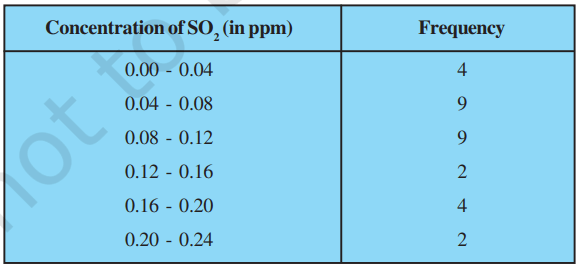
Find the mean concentration of SO2 in the air. SOLUTION
Mean = x? = ∑ fixi/∑ fi = 2.96/30 = 0.0986 Mean concentration of SO2 in the air is 0.0986 ppm. 8. A class teacher has the following absentee record of 40 students of a class for the whole term. Find the mean number of days a student was absent. 
SOLUTION
Mean = x? = ∑ fixi/∑ fi = 499/40 = 12.48 Mean number of days a student was absent is 12.48 9. The following table gives the literacy rate (in percentage) of 35 cities. Find the mean literacy rate. 
SOLUTION
Let us assume the mean to be A = 70 Class height = U.L - L.L = 10 True Mean = x? = A + h∑ fiui/∑ fi = 70 + 10(-2)/35 = 69.428 Mean literacy rate of a city is 69.428 % Exercise 14.21. The following table shows the ages of the patients admitted in a hospital during a year: 
Find the mode and the mean of the data given above. Compare and interpret the two measures of central tendency. SOLUTION The highest frequency in the given data is 23. Therefore, the modal class will be 35 - 45. l = 35 f1 = 23 f2 = 14 f0 = 21 Class width = h = 10 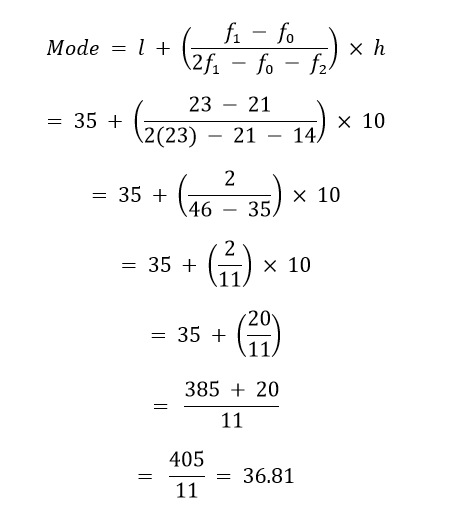
Mode = 36.81 years
Mean = x? = ∑ fixi/∑ fi = 2830/80 = 35.375 years Mean age of a patient is 35.375 years 2. The following data gives the information on the observed lifetimes (in hours) of 225 electrical components : 
Determine the modal lifetimes of the components. SOLUTION The highest frequency in the given data is 61. Therefore, the modal class will be 60 - 80. l = 60 f1 = 61 f2 = 38 f0 = 52 Class width = h = 20 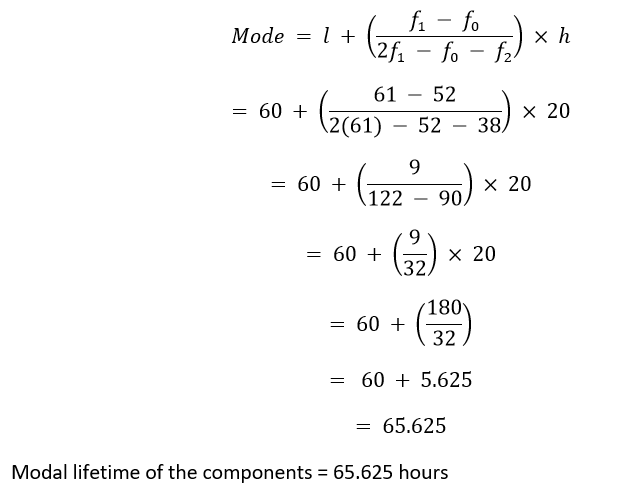
3. The following data gives the distribution of total monthly household expenditure of 200 families of a village. Find the modal monthly expenditure of the families. Also, find the mean monthly expenditure : 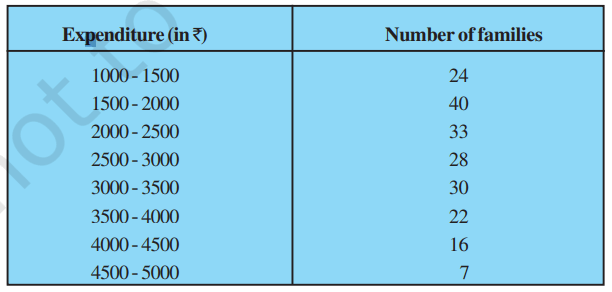
SOLUTION The highest frequency in the given data is 40. Therefore, the modal class will be 1500 - 2000. l = 1500 f1 = 40 f2 = 33 f0 = 24 Class width = h = 500 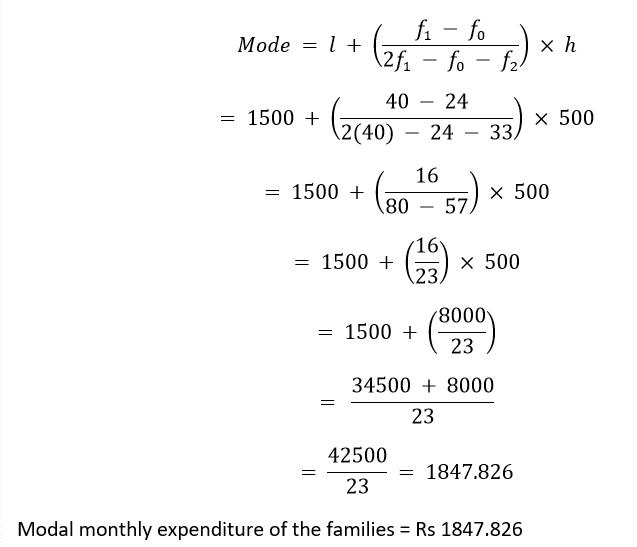
Let us assume the mean to be A = 2750 True mean = x? = A + h∑ fiui/∑ fi = 2750 + 500(-35)/200 = 2662.5 Mean monthly expenditure of the families = Rs 2662.5 4. The following distribution gives the state-wise teacher-student ratio in higher secondary schools of India. Find the mode and mean of this data. Interpret the two measures. 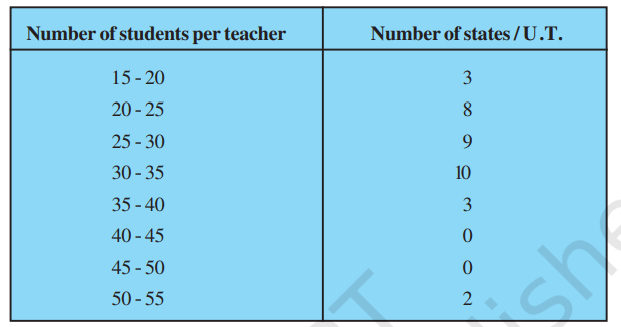
SOLUTION The highest frequency in the given data is 10. Therefore, the modal class will be 30 - 35. l = 30 f1 = 10 f2 = 3 f0 = 9 Class width = h = 5 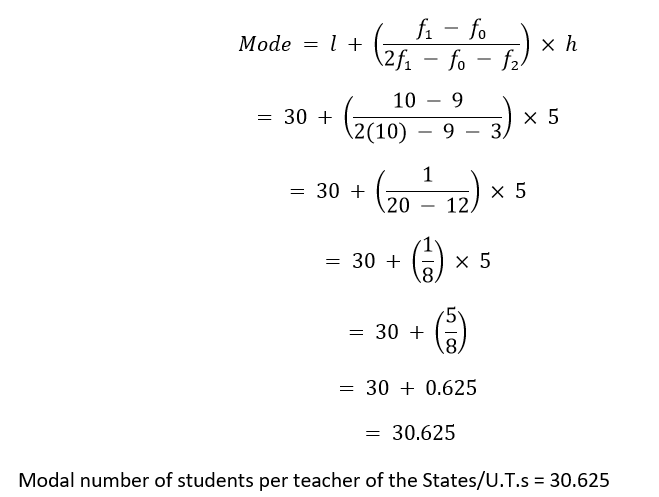
Mean = x? = ∑fixi/∑fi = 1022.5/35 = 29.214 Mean student-teacher ratio of the States/U.T.s = 29.214 5. The given distribution shows the number of runs scored by some top batsmen of the world in one-day international cricket matches. 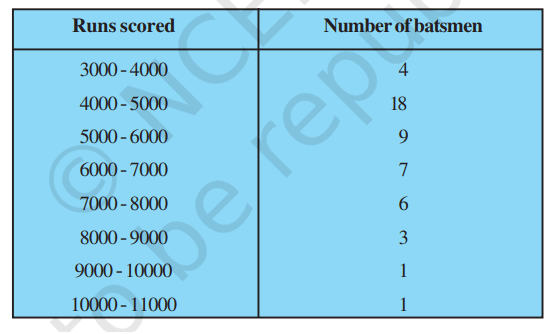
Find the mode of the data. SOLUTION The highest frequency in the given data is 18. Therefore, the modal class will be 4000 - 5000. l = 4000 f1 = 18 f2 = 9 f0 = 4 Class width = h = 1000 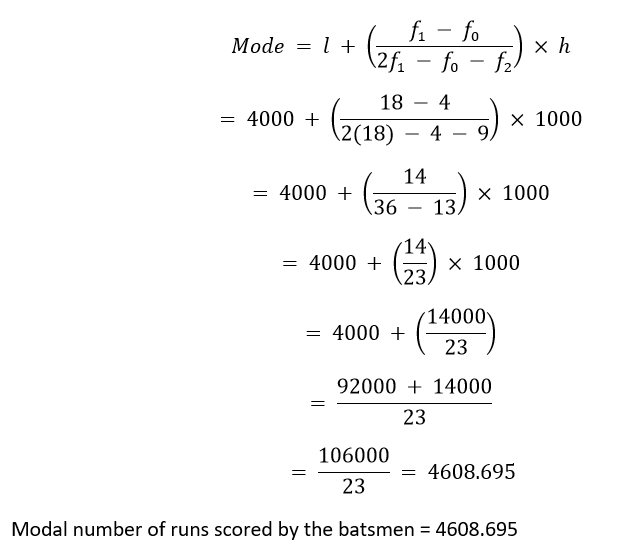
6. A student noted the number of cars passing through a spot on a road for 100 periods each of 3 minutes and summarised it in the table given below. Find the mode of the data : 
SOLUTION The highest frequency in the given data is 20. Therefore, the modal class will be 40 - 50. l = 40 f1 = 20 f2 = 11 f0 = 12 Class width = h = 10 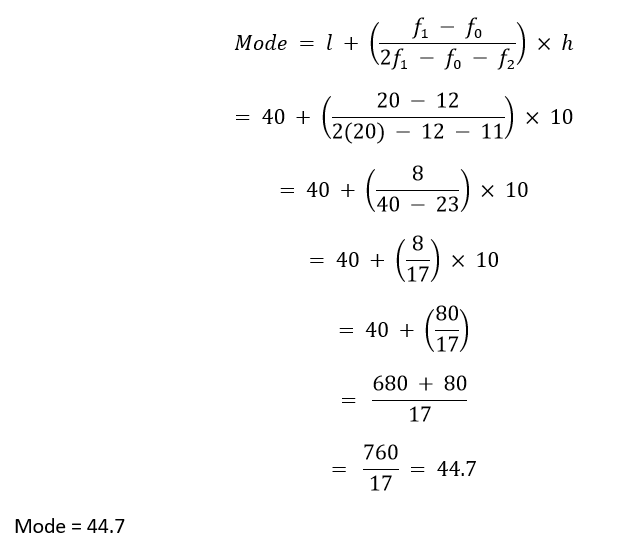
Exercise 14.31. The following frequency distribution gives the monthly consumption of electricity of 68 consumers of a locality. Find the median, mean and mode of the data and compare them. 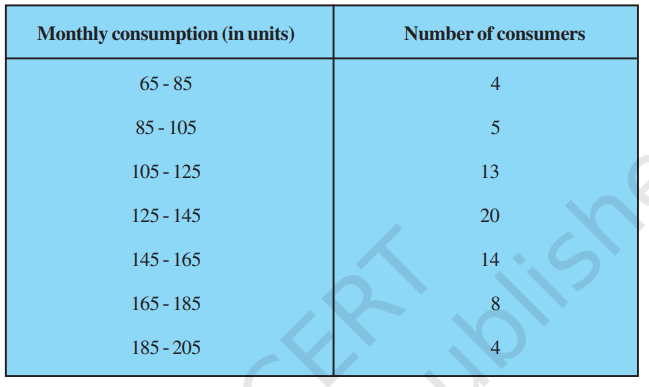
SOLUTION
n = 68 n/2 = 34 Therefore, the median class will be 125 - 145 and cumulative frequency is 42 l = 125 f = 20 cf = 22 Class height = h = 20 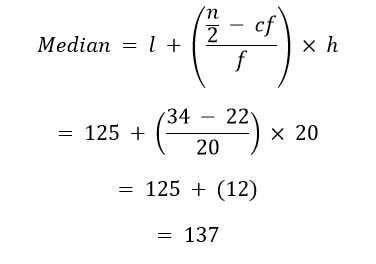
Median monthly consumption = 137 units The highest frequency in the given data is 20. Therefore, the modal class will be 125 - 145. l = 125 f1 = 20 f2 = 14 f0 = 13 Class width = h = 20 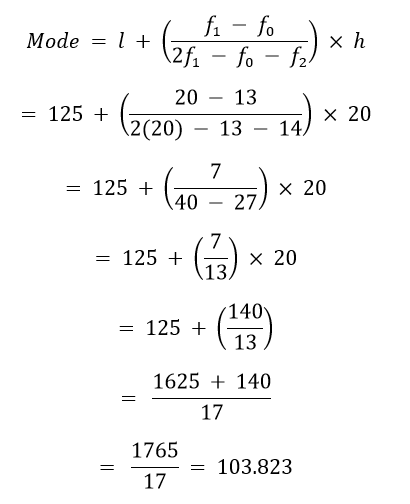
Mode = 103.823
Let us assume the mean to be A = 135 True Mean = x? = A + h∑ fiui/∑ fi = 135 + 20(7)/68 = 137.06 Mean monthly consumption is 137.06 units. On comparison of mean, median and mode of the data, we can conclude that they are approximately equal to each other. 2. If the median of the distribution given below is 28.5, find the values of x and y. 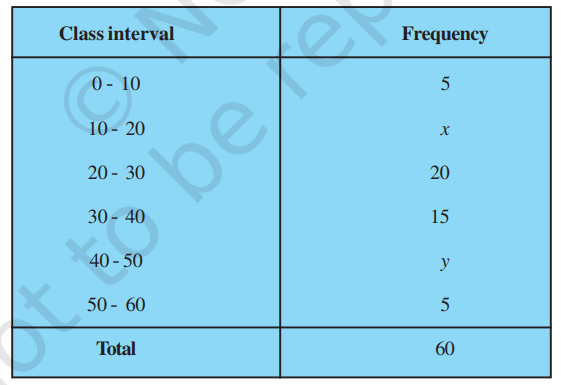
SOLUTION
n = 60 n/2 = 30 Therefore, the median class will be 20 - 30 with cumulative frequency 25 + x l = 20 f = 20 cf = 5 + x Class height = h = 10 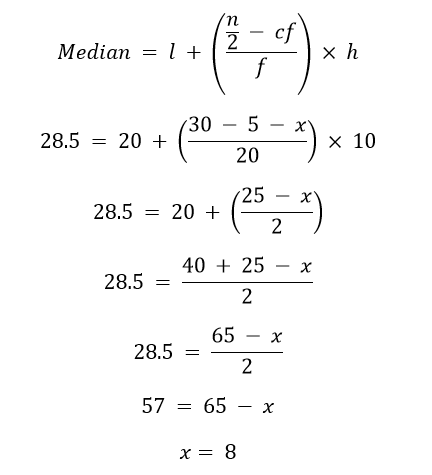
∑ fi = 45 + x + y = n 45 + 8 + y = 60 53 + y = 60 y = 7 Hence, the values of x and y are 8 and 7 respectively. 3. A life insurance agent found the following data for distribution of ages of 100 policy holders. Calculate the median age, if policies are given only to persons having age 18 years onwards but less than 60 year. 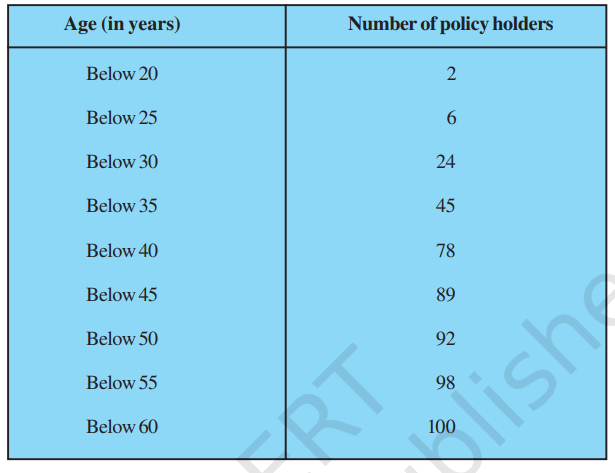
SOLUTION
n = 100 n/2 = 50 Therefore, the median class will be 35 - 40 with cumulative frequency = 78 l = 35 f = 33 cf = 45 Class height = h = 5 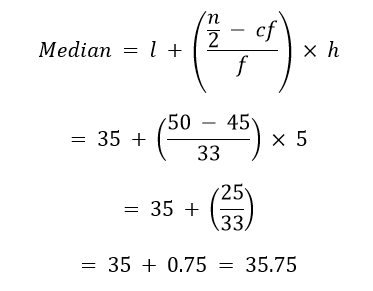
Median age = 35.75 years 4. The lengths of 40 leaves of a plant are measured correct to the nearest millimetre, and the data obtained is represented in the following table : 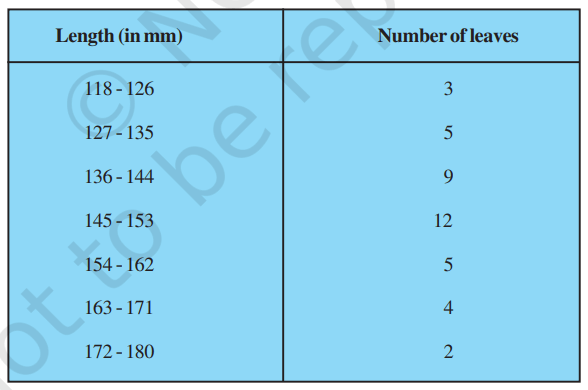
Find the median length of the leaves. (Hint : The data needs to be converted to continuous classes for finding the median, since the formula assumes continuous classes. The classes then change to 117.5 - 126.5, 126.5 - 135.5, . . ., 171.5 - 180.5.) SOLUTION Since the data isn't continuous, we will add 0.5 to all the Upper Limit values and subtract 0.5 from all the Lower Limit values.
n = 40 n/2 = 20 Therefore, the median class will be 144.5 - 153.5 with cumulative frequency = 29 l = 144.5 f = 12 cf = 17 Class height = h = 9 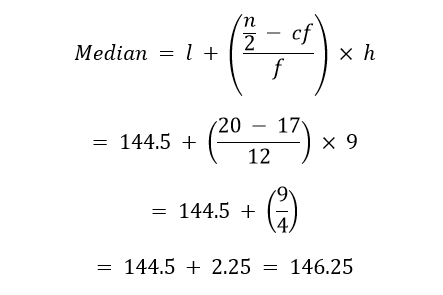
Median length of the leaves = 146.25 mm. 5. The following table gives the distribution of the life time of 400 neon lamps : 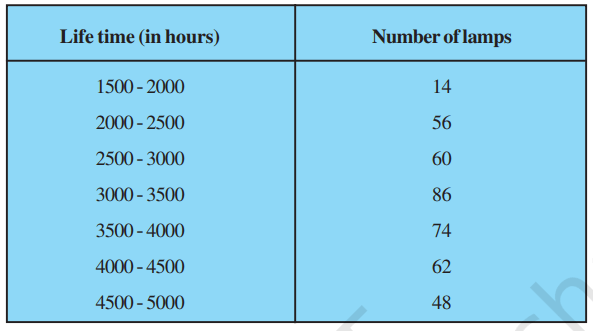
Find the median life time of a lamp. SOLUTION
n = 400 n/2 = 200 Therefore, the median class will be 3000 - 3500 with cumulative frequency = 216 l = 3000 f = 86 cf = 130 Class height = h = 500 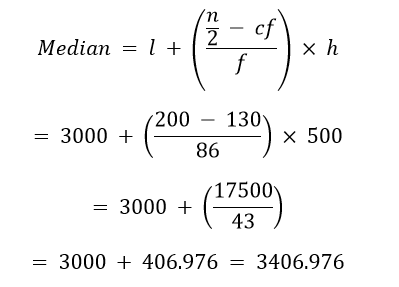
Median life time of a lamp = 3406.976 hours 6. 100 surnames were randomly picked up from a local telephone directory and the frequency distribution of the number of letters in the English alphabets in the surnames was obtained as follows: 
Determine the median number of letters in the surnames. Find the mean number of letters in the surnames? Also, find the modal size of the surnames. SOLUTION
n = 100 n/2 = 50 Therefore, the median class will be 7 - 10 with cumulative frequency = 76 l = 7 f = 40 cf = 36 Class height = h = 3 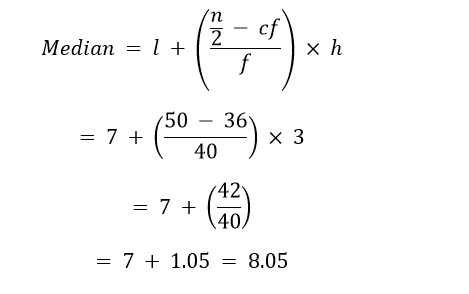
Median number of letters = 8.05
Mean = x? = ∑ fixi/∑ fi = 825/100 = 8.25 Mean number of letters = 8.25 The highest frequency in the given data is 40. Therefore, the modal class will be 7 - 10. l = 7 f1 = 40 f2 = 16 f0 = 30 Class width = h = 3 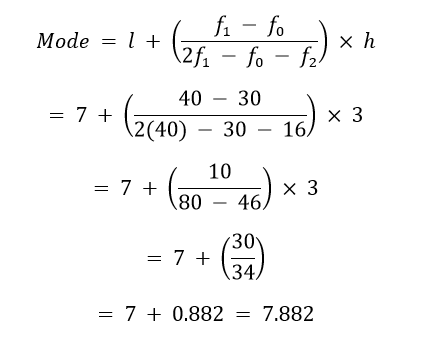
Modal number of letters = 7.882 7. The distribution below gives the weights of 30 students of a class. Find the median weight of the students. 
SOLUTION
n = 30 n/2 = 15 Therefore, the median class will be 55 - 60 with cumulative frequency = 19 l = 55 f = 6 cf = 13 Class height = h = 5 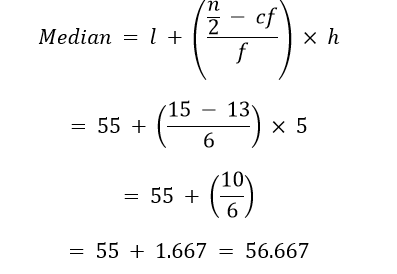
Median weight of the students = 56.667 kg Exercise 14.41. The following distribution gives the daily income of 50 workers of a factory. 
Convert the distribution above to a less than type cumulative frequency distribution, and draw its ogive. SOLUTION We need to convert the data into less than type distribution and find cumulative frequencies.
Using the upper limits and the corresponding cumulative frequencies, we can obtain the points (120, 12), (140, 26), (160, 34), (180, 40), and (200, 50). We will plot a graph with these coordinates and join the points to obtain the less than type ogive curve. 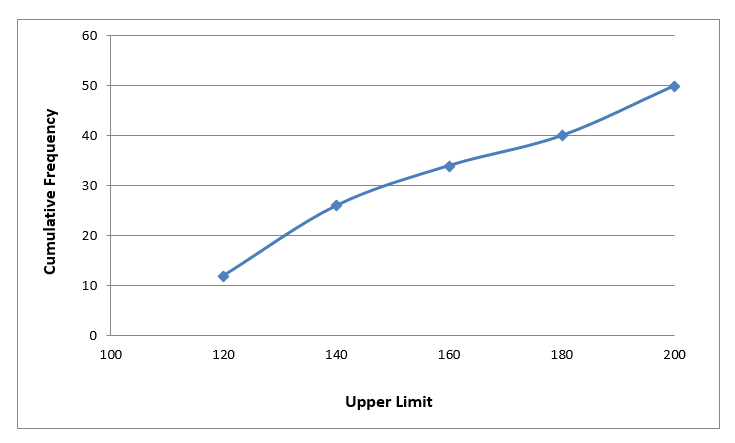
2. During the medical check-up of 35 students of a class, their weights were recorded as follows: 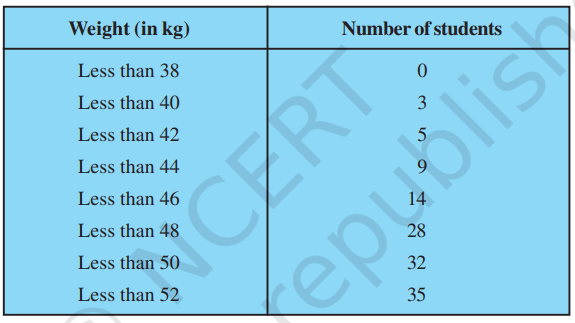
Draw a less than type ogive for the given data. Hence obtain the median weight from the graph and verify the result by using the formula. SOLUTION Using the upper limits and the corresponding cumulative frequencies, we can obtain the points (38, 0), (40, 3), (42, 5), (44, 9), (46, 14), (48, 28), (50, 32) and (52, 35). We will plot a graph with these coordinates and join the points to obtain the less than type ogive curve. 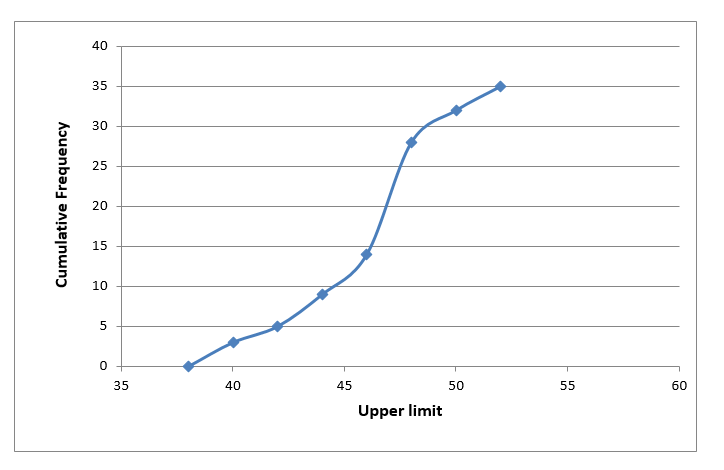
Sum of frequencies is 35. Therefore, we will locate the point 35/2 = 17.5 on the y-axis or the cumulative frequency axis. Produce a line parallel to x-axis through the point (0, 17.5) until it meets the ogive curve. Draw the perpendicular at the point at which this line intersects the ogive curve. The coordinates of this point are found out to be (46.5, 17.5). Therefore, 46.5 is the median weight of the students from the given data. Verification : We need to find the actual frequencies.
n = 35 n/2 = 17.5 Therefore, the median class will be 46 - 48 with cumulative frequency = 28 l = 46 f = 14 cf = 14 Class height = h = 2 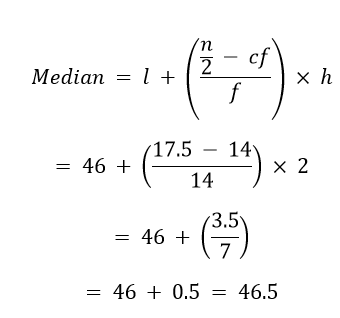
Median weight of the students = 46.5 kg Hence, the median weight of students has been verified. 3. The following table gives production yield per hectare of wheat of 100 farms of a village. 
Change the distribution to a more than type distribution, and draw its ogive. SOLUTION We need to convert the given data to more than type distribution and find out the cumulative frequencies.
Using the upper limits and the corresponding cumulative frequencies, we can obtain the points (50, 100), (55, 90), (60, 90), (65, 78), (70, 54) and (75, 16). We will plot a graph with these coordinates and join the points to obtain the more than type ogive curve. 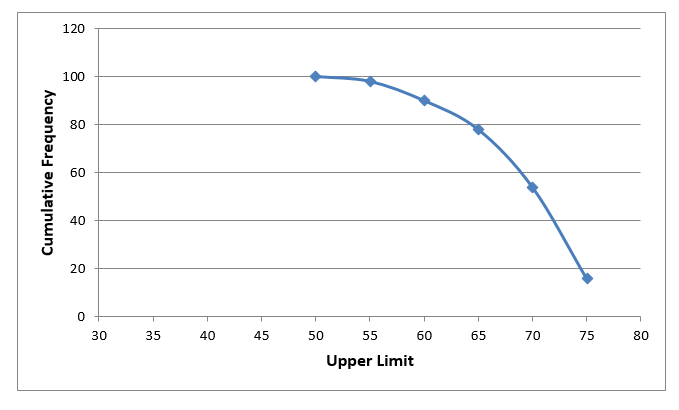
Next TopicNCERT Solutions Class 10 Science
|
 For Videos Join Our Youtube Channel: Join Now
For Videos Join Our Youtube Channel: Join Now
Feedback
- Send your Feedback to [email protected]
Help Others, Please Share









